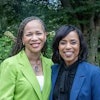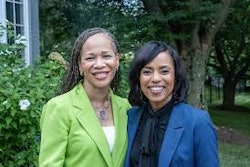 Dr. J. Luke Wood, vice president for student affairs and campus diversity, chief diversity officer, and Dean’s Distinguished Professor of Education at San Diego State University.
Dr. J. Luke Wood, vice president for student affairs and campus diversity, chief diversity officer, and Dean’s Distinguished Professor of Education at San Diego State University.
“I knew to put it in the ‘Racism Box,’ and knew that I wasn’t inviting them to my birthday party,” said Wood. “But as I got older, [those epithets] became more subtle—dismissive looks and put-downs. I didn’t know what to do with that.”
That haziness and confusion is called “attribution ambiguity” and is intrinsically connected with “racelighting,” a term developed by Wood and his colleague at San Diego State University (SDSU), Dr. Frank Harris III, to describe the way in which people of color are, through macro and microaggressions, encouraged to question their own value and lived experiences with racism.
Wood, vice president for student affairs and campus diversity, chief diversity officer, and Dean’s Distinguished Professor of Education at SDSU, discussed the idea of racelighting at the University of Phoenix’s Inclusive Leadership Summit on Thursday. The event was co-sponsored by Diverse and the Educational Testing Service (ETS).
Wood shared how racelighting impacts Black, Indigenous, and People of Color (BIPOC) employees and students and provided suggestions on how institutions can better protect these individuals.
Racelighting is derived from ‘gaslighting,’ which comes from the 1938 play Gas Light by Patrick Hamilton. In the story, Jack terrorizes his wife Bella by changing the environment she lives in. When she mentions these changes to Jack, he purposefully manipulates her by telling her she’s imagining things.
Gaslighting is more commonly understood to relate to abusive relationships between a man and a woman but has more recently been broadened to connect with other forms of marginality.
That marginality is felt even more keenly in after spring and summer of 2020, as Wood explained the “dual pandemics” facing minoritized communities—not just the disproportionate impact of COVID-19 but also the murders of George Floyd, Breonna Taylor, Ahmaud Arbery, and others.
“It meant there was a lot of trauma experienced by people as a result of this crisis,” said Wood. “Even though we’re coming out of the pandemic, the trauma doesn’t just go away. It’s one that we as a community and nation are still grieving, processing the challenges of what occurred.”
Wood said that racelighting stands on the framework of a nation built on slavery, white supremacy, and white nationalism. These hateful ideals are no longer fringe beliefs, said Wood, but have moved rapidly into mainstream society, culminating in events like the January 6th insurrection at The U.S. Capitol.
“I can say, as chief diversity officer, I’ve seen [that ideology] move from the margins, conversations that disparage BIPOC and LGBTQIA+ and disability,” said Wood. “It’s become commonplace. We must take it into account, and it has to change.”
Hate spreads through explicit bias, in the form of swastikas and anti-Blackness flyers distributed on campuses, and through implicit bias, the cultural output created through something as simple as turning on the television and routinely seeing police search for suspects of color.
“Everyone is susceptible [to implicit bias],” said Wood. “It affects how we talk to one another, engage one another in interpersonal relationships and nonverbal relationships. It motivates our actions in every single way. With implicit bias, we have to separate intent from impact.”
These biases create the environment for microaggressions: othering, assumed lack of intelligence or criminality, denial of racism, or people of color being seen as oversensitive.
“As a Black male, it’s often said to me, ‘oh wow, you’re so articulate,’” said Wood. “It’s not a compliment, it’s a sense of surprise: What’s really said is, ‘I didn’t think you would be.’ For students on campus at night, what [authority figures] say is, “Can I see your ID?’ What’s unsaid is, ‘I think you’re here to steal something.’”
When BIPOC students, faculty, or staff lift their voices to share their experience, they can often experience racelighting as a response. Wood used the case of Korematsu vs. the United States as an example. Fred Korematsu argued that the ordering of Japanese Americans to detention camps was racist. The U.S. argued that it was not racist but done to protect the nation. The U.S. won.
“If you’re ever in this situation, and you begin to say to yourself, ‘Maybe I’m not as smart as I thought I was, maybe I don’t belong here,' that’s racelighting. It can lead people of color to second guess their experiences, even questioning our basic humanity,” said Wood. “That’s why we have to change our culture and the way we approach environments in work.”
That culture change will take much more than the performative gestures, what Wood called “inauthentic allyship.” After the murder of George Floyd, Wood said companies, universities and colleges released statements of solidarity with the Black community but offered no accompanying action.
“Inauthentic allyship is the worst possible type of being an ally,” said Wood. “We see these things occur and then we think, again, something’s wrong with us, when really, all we’re asking for is dignity within our organizations.”
For those experiencing racelighting or inauthentic allyship at their institutions, Wood recommends practicing radical self-care, as “a racist environment doesn’t want you to take care of yourself.” He also advocated documenting the experiences as the process can be cathartic.
For organizations looking to make true change, Wood encouraged listening to and believing what BIPOC employees say. He urged institutions to establish a bias response reporting system and create groups for marginalized employees to connect with each other. Faculty can create “underground railroads,” helping underrepresented students in need of help connect with supportive and understanding administrators.
“I encourage you to remember one very important thing – racelighting is real. It occurs, it effects all of us, and therefore we have to be committed to changing our organizations,” said Wood. “If we don’t, they’ll never be as good as they could be in serving the people.”
Liann Herder can be reached at [email protected].



















